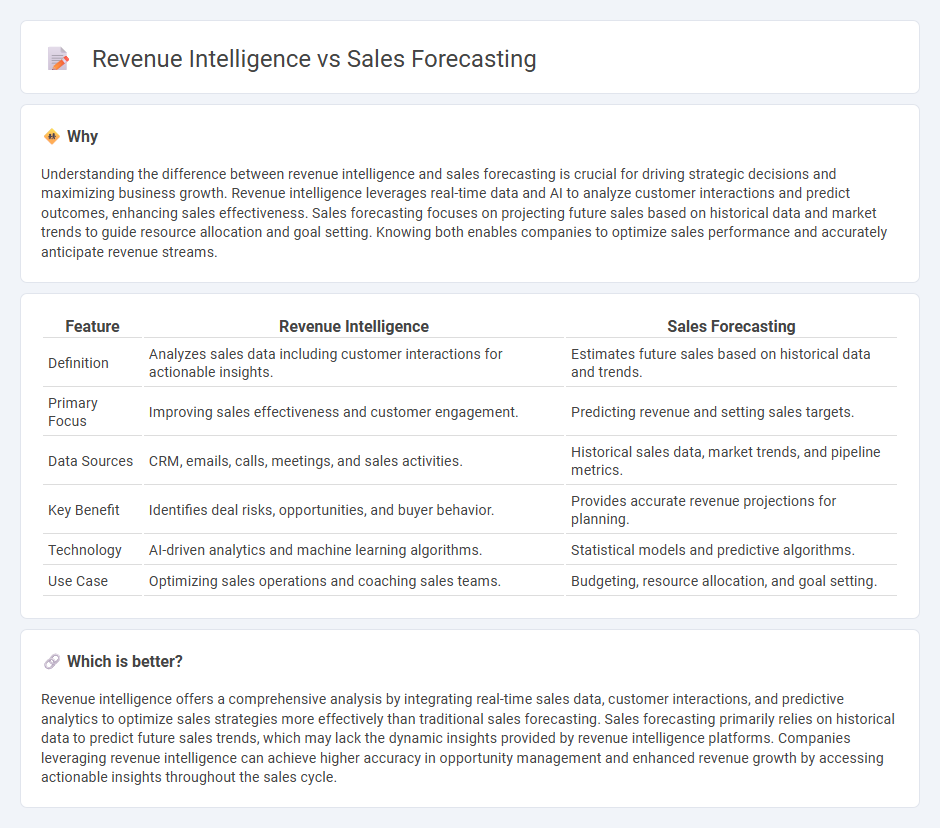
Revenue intelligence analyzes historical sales data and customer interactions to provide actionable insights that optimize sales performance and improve deal outcomes. Sales forecasting predicts future revenue by evaluating trends, market conditions, and sales team capacity to guide strategic planning and quota setting. Discover how integrating revenue intelligence with sales forecasting can transform your sales strategy and boost accuracy.
Why it is important
Understanding the difference between revenue intelligence and sales forecasting is crucial for driving strategic decisions and maximizing business growth. Revenue intelligence leverages real-time data and AI to analyze customer interactions and predict outcomes, enhancing sales effectiveness. Sales forecasting focuses on projecting future sales based on historical data and market trends to guide resource allocation and goal setting. Knowing both enables companies to optimize sales performance and accurately anticipate revenue streams.
Comparison Table
| Feature | Revenue Intelligence | Sales Forecasting |
|---|---|---|
| Definition | Analyzes sales data including customer interactions for actionable insights. | Estimates future sales based on historical data and trends. |
| Primary Focus | Improving sales effectiveness and customer engagement. | Predicting revenue and setting sales targets. |
| Data Sources | CRM, emails, calls, meetings, and sales activities. | Historical sales data, market trends, and pipeline metrics. |
| Key Benefit | Identifies deal risks, opportunities, and buyer behavior. | Provides accurate revenue projections for planning. |
| Technology | AI-driven analytics and machine learning algorithms. | Statistical models and predictive algorithms. |
| Use Case | Optimizing sales operations and coaching sales teams. | Budgeting, resource allocation, and goal setting. |
Which is better?
Revenue intelligence offers a comprehensive analysis by integrating real-time sales data, customer interactions, and predictive analytics to optimize sales strategies more effectively than traditional sales forecasting. Sales forecasting primarily relies on historical data to predict future sales trends, which may lack the dynamic insights provided by revenue intelligence platforms. Companies leveraging revenue intelligence can achieve higher accuracy in opportunity management and enhanced revenue growth by accessing actionable insights throughout the sales cycle.
Connection
Revenue intelligence leverages artificial intelligence and data analytics to provide real-time insights into sales activities, customer behavior, and revenue patterns. Sales forecasting utilizes these insights to create more accurate predictions of future sales performance, helping businesses allocate resources effectively and set achievable targets. The integration of revenue intelligence with sales forecasting improves decision-making by reducing uncertainty and highlighting growth opportunities.
Key Terms
Sales Forecasting:
Sales forecasting uses historical sales data, market trends, and statistical models to predict future sales performance, enabling businesses to plan inventory, allocate resources, and set realistic targets. It emphasizes quantitative analysis and time-series data to generate accurate short-term and long-term sales projections. Explore how integrating advanced analytics can enhance your sales forecasting accuracy and drive better business outcomes.
Pipeline Projections
Sales forecasting uses historical data and current sales activities to project future revenue, focusing on accurate pipeline projections and deal closure probabilities. Revenue intelligence analyzes customer interactions and CRM data to provide actionable insights that enhance sales strategies and pipeline management. Explore how combining sales forecasting and revenue intelligence can optimize your pipeline projections for improved business outcomes.
Historical Data Analysis
Sales forecasting relies heavily on historical data analysis, utilizing past sales trends, seasonality, and customer behavior to predict future sales performance accurately. Revenue intelligence goes beyond by integrating this historical data with real-time insights from CRM systems, communication patterns, and market conditions to optimize sales strategies. Explore deeper to understand how leveraging both can transform your business outcomes.
Source and External Links
Sales Forecasting | Salesforce - Sales forecasting estimates expected sales revenue over a defined period by analyzing historical data, current pipelines, and market conditions using methods like historical, pipeline, or combined forecasting to project future sales figures.
Sales Forecasting Methods: A Beginner's Guide - Anaplan - Sales forecasting predicts future revenue by estimating product or service sales for upcoming periods and is critical for budget, capacity planning, and aligning go-to-market strategies across organizations using various forecasting types such as opportunity or retail sales forecasting.
Sales Forecasting 101: The Ultimate Guide - Salesloft - For businesses with historical sales data, sales forecasting uses techniques like trend analysis and exponential smoothing to project monthly unit sales and prices, thereby enabling more accurate revenue projections.
 dowidth.com
dowidth.com